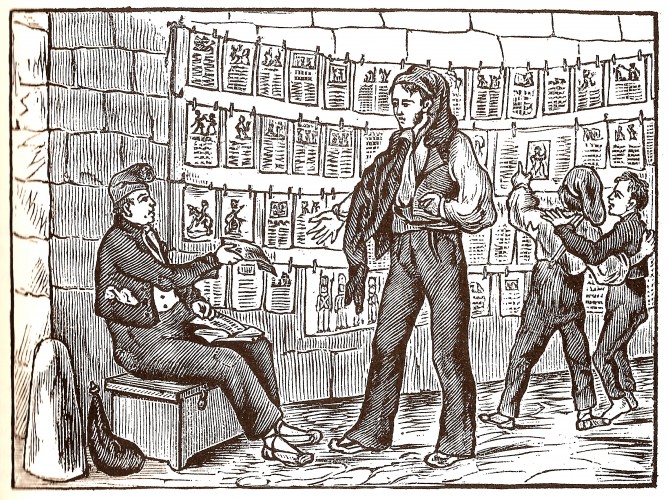We have recently purchased an extremely rare illustrated history of Spain. It consists of just twenty-four oblong leaves (152 x 262 mm), each of them containing six illustrations with their respective descriptive narratives below. Each of these pairs highlights important events in Spanish history from Antiquity until the reign of Philip V (1700-1746). There is no letterpress involved in the making of this book. The rectos of the pages have been entirely designed and printed by using the process of copperplate engraving.
![Engraved page from [Historia de España en imágenes] Barcelona : Nicolás Roca & María Teresa Sellent,](/sites/default/files/blogs/readingroom/plate1.jpg)
Engraved page from [Historia de España en imágenes] Barcelona : Nicolás Roca & María Teresa Sellent, 1800-1802
Initially, one might think that the publishers merely intended to reach a young audience who needed to learn the main facts of Spanish history with the traditional aid of very explicit illustrations. But after examining these plates carefully, one realizes that in fact this book elegantly echoes a long tradition of oral storytelling that found a concrete manifestation through the so-called literatura de cordel. Essentially, this Spanish phrase describes a particular practice to disseminate popular literature. Shortly after the introduction of printing in the Spanish peninsula at the end of the fifteenth century, peddlers went from town to town selling individual printed sheets (pliegos) containing illustrations with poems. Forming a gathering of several pages, they could be read aloud, or even sung, to a group who did not know how to read. The most popular way to advertise this material was to hang the sheets with pegs in a clothes line (cordel), as exemplified in the image of a nineteenth-century woodcut below.

Tienda de "romanços" (shop of Romances) by the convent of San Agustín (Barrio de la Ribera, Barcelona) as depicted in a woodcut included in a sainete published in 1850.
The illustrations of our book are fairly stylish, perhaps designed by well-established artists. Each of them is accompanied by ten verses of eight syllables, forming a stanza called Décima Espinela. First used by the Spanish writer and musician Vicente Espinel (1550-1620), this type of décima could be used for many different topics, including popular songs. To facilitate memorization, it includes a consonant rhyme in the following pattern: abbaaccddc. Here is an example of how this book worked. The two details shown below depict an episode of the Dutch Revolt (1568-1648) of the Protestant Seven Provinces of the Low Countries against the rule of Philip II of Spain. This rebellion was brutally, and also temporarily, suppressed in Brussels by the third Duke of Alba, Fernando Álvarez de Toledo.
![Detail from [Historia de España en imágenes] Barcelona : Nicolás Roca & María Teresa Sellent,](/sites/default/files/blogs/readingroom/detailsuper.jpg)
Detail from [Historia de España en imágenes] Barcelona : Nicolás Roca & María Teresa Sellent, 1800-1802
![Text in Décima Espinela from [Historia de España en imágenes] Barcelona : Nicolás Roca & María Teresa Sellent, 1800-1802](/sites/default/files/blogs/readingroom/detailsuper2.jpg)
Text in Décima Espinela from [Historia de España en imágenes] Barcelona : Nicolás Roca & María Teresa Sellent, 1800-1802
![Detail from Historia de España en imágenes] Barcelona : Nicolás Roca & María Teresa Sellent, 1800-1802](/sites/default/files/blogs/readingroom/detailsuper3.jpg)
Detail from [Historia de España en imágenes] Barcelona : Nicolás Roca & Teresa Sellent, 1800-1802
![Text in Décima Espinela from [Historia de España en imágenes] Barcelona : Nicolás Roca & María Teresa Sellent, 1800-1802](/sites/default/files/blogs/readingroom/detailsuper4.jpg)
Text in Décima Espinela from [Historia de España en imágenes] Barcelona : Nicolás Roca & María Teresa Sellent, 1800-1802
Some of the pages include the following caption: Se vende en Barcelona, debajo de los arcos de los encantes, en la Fabrica de Estampas de Nicolas Roca y Ma Teresa Sellent. It means that each of these plates was originally sold in Barcelona, under the arch of the encantes, in the engraving shop of Nicolas Roca y María Teresa Sellent. As mentioned above, this collection of plates is very rare. According to WorldCat, currently only one library is listed as holding these engravings: the Biblioteca Universitat de Barcelona.
![Page from [Historia de España en imágenes] Barcelona : Nicolás Roca & María Teresa Sellent, 1800-1802](/sites/default/files/blogs/readingroom/plate2.jpg)
Engraved page from [Historia de España en imágenes] Barcelona: Nicolás Roca & María Teresa Sellent, 1800-1802